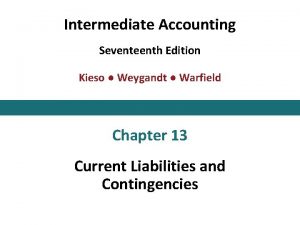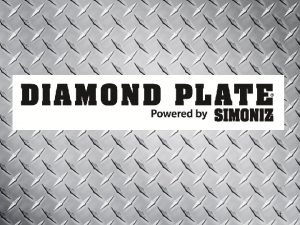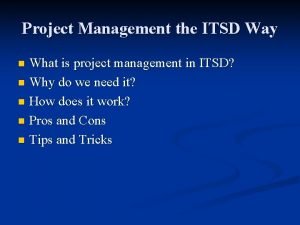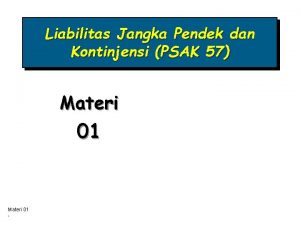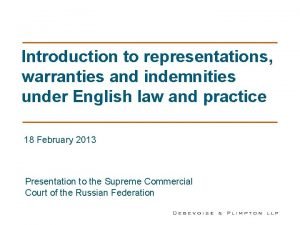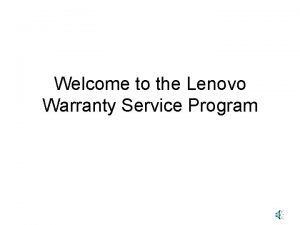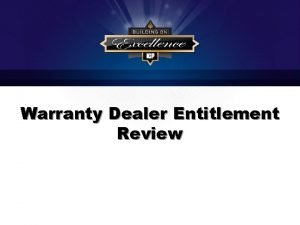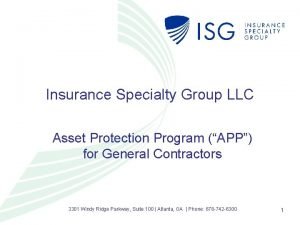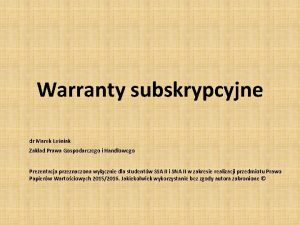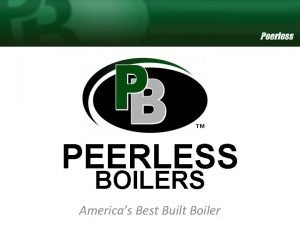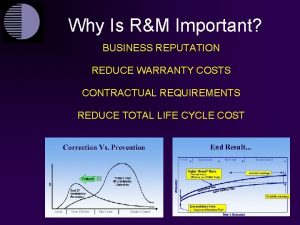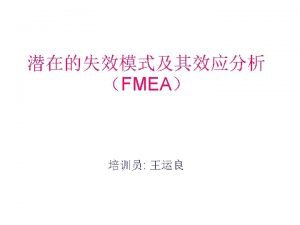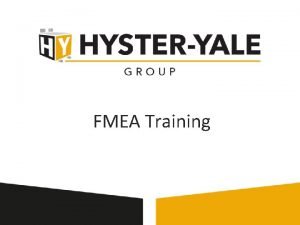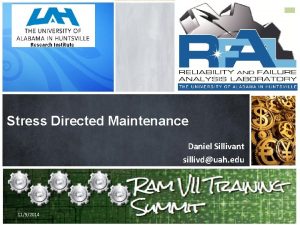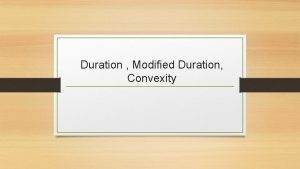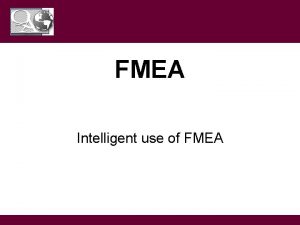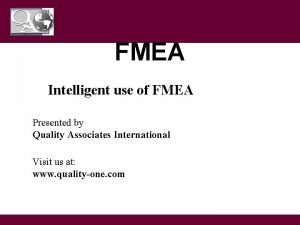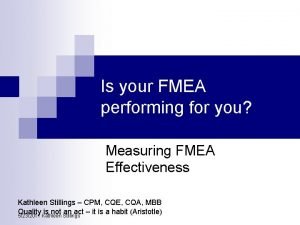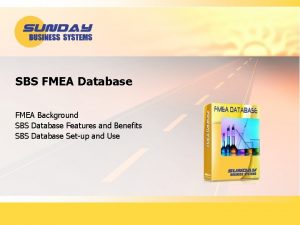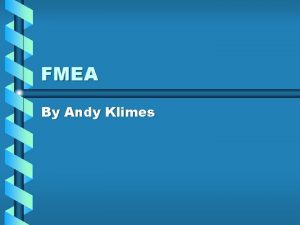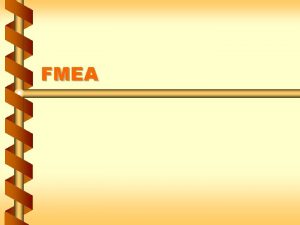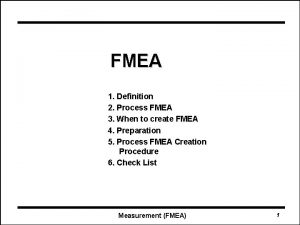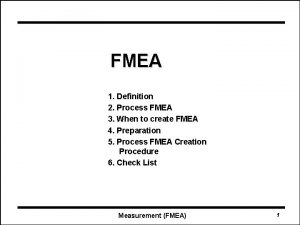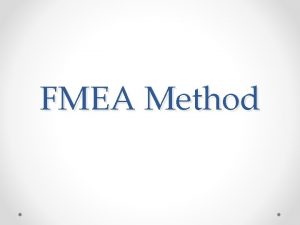Using FMEA to Address Warranty Duration Daniel Sillivant

















- Slides: 17

Using FMEA to Address Warranty Duration Daniel Sillivant University of Alabama in Huntsville Daniel. Sillivant@UAH. edu 10/27/2015

Outline • • • FMEA Process Reliability Block Diagrams Critical Items List MTBF and Reliability Calculations OC Curve for Number of Tests Warranty Decisions RAM VIII Training Summit 2 November 3 -4, 2015

Failure Mode and Effect Analysis ( FMEA) FMEA: Methodology designed to identify potential failure modes • Basic Procedure: – Identify the item(s) to be analyzed – Identify the • • Function(s), Failure Mechanism(s) (Cause) Failure Mode(s) (How) Failure Effect(s) (Results) – Evaluate the issues identified by the analysis – Additional Tools • Critical Items List (CIL) • Reliability Block Diagram (RBD) • Reliability Calculations – Warranty Confidence - OC Curves • Physical Testing RAM VIII Training Summit 3 November 3 -4, 2015

Sources of Failure Mechanisms • Transportation – Packing – Handling at each stage of shipment from origin to end user – Truck, Rail, Aviation & Sea • Storage – Distribution chain – At end user • Operational conditions of use (intrinsic) – Result from system function • Ambient conditions of use (extrinsic) – Result from environmental exposure and from proximate parts functionality RAM VIII Training Summit 4 November 3 -4, 2015

Failure Mechanisms (Causes) Questions: • What mechanism (Stress) caused the failure? • How can the failure occur? • What could cause the part to fail? • Why could the failure occur? • Are there possible system interactions, operating environments, customer usages that could cause the failure? Examples: • Stresses acting upon the part/system – Thermal Shock – Physical Shock – Heat/Cold Soak RAM VIII Training Summit 5 November 3 -4, 2015

Failure Modes (How) Questions: • What are the results of the Failure Mechanism acting upon the part? • How did the part fail because of the failure mechanism? • • • How could the part fail to perform its intended function? What could go wrong with this part ? What has gone wrong with this part in the past? How could the part be abused or misused? What concerns do you have with this design/ part? Examples: • Change in shape – Strain, flexure, bending • Change in geometry – Crack initiation & propagation, fracture, wear-out, pitting, galling • Change in material properties • Corrosion, intermetallic compounds, embrittlement, UV decay RAM VIII Training Summit 6 November 3 -4, 2015

Failure Effects (Results) Questions: • What happens to the part with that failure mode? • What happens to the system with that failure mode? Examples: • Part: Light doesn’t work • System: Performs its intended function RAM VIII Training Summit 7 November 3 -4, 2015

FMEA Template Part Nomenclature Part Source of Failure Mechanisms Transportation Storage Operation Ambient Failure Mechanism RAM VIII Training Summit Failure Modes Failure Effects 8 November 3 -4, 2015

Reliability Block Diagram Part 3. 1 Part 2 Part 4 Part 3. 2 Part 5 RAM VIII Training Summit Part 6 9 Part 7 November 3 -4, 2015

Critical Items List Part Operating Condition Part 1 Part 2 Part 3. 1 Part 3. 2 Part 4 Part 5 Part 6 Part 7 -55°C - 125°C -60°C - 105°C -40°C - 85°C -55°C - 150°C -65°C - 150°C RAM VIII Training Summit MTBF 10 Reliability Year 1 Reliability Year 3 November 3 -4, 2015

MTBF Determination MIL-HDBK 217 Results Parameter http: //www. sqconline. com/military -handbook-mil-hdbk-217 -beta RAM VIII Training Summit λp Value 0. 000001 Failures/106 Hours MTBF FIT 11 7. 759265 e+11 hours 0. 001289 Failures/109 Hours November 3 -4, 2015

Reliability Equations FIT – Failures per Billion hours Failure Rate (Landa) Reliability Equation RAM VIII Training Summit 12 November 3 -4, 2015

MTBF Determination Part Operating Range FIT MTBF (Hrs) λ 1 3 5 Part 1 Part 2 Part 3. 1 Part 3. 2 Part 4 Part 5 Part 6 Part 7 -55°C - 125°C -60°C - 105°C -40°C - 85°C -55°C - 150°C -65°C - 150°C 269. 60 299. 18 368. 07 557. 09 685. 37 395. 13 331. 68 408. 05 4. 64 E+05 1. 11 E+06 1. 36 E+06 1. 80 E+06 7. 30 E+05 8. 44 E+05 6. 03 E+05 1. 23 E+06 2. 16 E-06 8. 98 E-07 7. 36 E-07 5. 57 E-07 1. 37 E-06 1. 19 E-06 1. 66 E-06 8. 16 E-07 0. 9813 0. 9922 0. 9936 0. 9951 0. 9881 0. 9897 0. 9856 0. 9929 0. 9449 0. 9767 0. 9808 0. 9855 0. 9646 0. 9693 0. 9573 0. 9788 0. 9098 0. 9614 0. 9683 0. 9759 0. 9417 0. 9494 0. 9299 0. 9649 RAM VIII Training Summit 13 November 3 -4, 2015

Weak Links • Operating Conditions – Parts not rated for stated conditions of use • Low MTBF • Components that are not redundant RAM VIII Training Summit 14 November 3 -4, 2015

Testing Failure Mechanisms • Heat / Cold • • Vibration • Thermal • Shock • Physical Shock Humidity Corrosion Equipment Used for Testing • • Fatigue Testing - Instron HALT chamber Thermal Shock Cyclic Corrosion Chamber Drop Test Altitude Chamber Dynamic Vibration System Environmental Chamber RAM VIII Training Summit 15 November 3 -4, 2015

OC Curves Number of Tests Needed # of Failures χ2 T n=3 n=5 n=7 n = 10 n = 15 0 4. 605 62170 863 518 370 259 173 1 7. 779 105022 1459 875 625 438 292 2 10. 645 143703 2994 1497 998 665 428 3 13. 362 180381 7516 2505 1503 939 578 4 15. 987 215827 4496 2248 1285 749 5 18. 549 250416 10434 3478 1739 949 TABLE. OC Curves. 27, 000 hrs (3. 080 years) θLCL = 0. 1 for Confidence α = 10000 9000 n = 3 n = 5 n = 7 n = 10 n = 15 8000 Hours 7000 6000 5000 4000 3000 2000 1000 0 0 1 2 3 # of Failures RAM VIII Training Summit 4 5 16 November 3 -4, 2015

Questions RAM VIII Training Summit 17 November 3 -4, 2015
 In a service-type warranty, warranty revenue is
In a service-type warranty, warranty revenue is Memory swaping
Memory swaping Constant pointer and pointer to constant
Constant pointer and pointer to constant Simoniz glasscoat warranty claim
Simoniz glasscoat warranty claim Cisco enhanced limited lifetime warranty
Cisco enhanced limited lifetime warranty What is project work
What is project work Contoh liabilitas kontinjensi
Contoh liabilitas kontinjensi Warranty disclosure
Warranty disclosure Warranty template
Warranty template Warranty condition
Warranty condition Lenovo warranty policy
Lenovo warranty policy Www servicebench com login
Www servicebench com login Asset protection for contractors
Asset protection for contractors Warranty subskrypcyjne wady i zalety
Warranty subskrypcyjne wady i zalety Peerless boilers distributors
Peerless boilers distributors How to record contingent liability
How to record contingent liability Relex alternatives
Relex alternatives Fmea types
Fmea types
